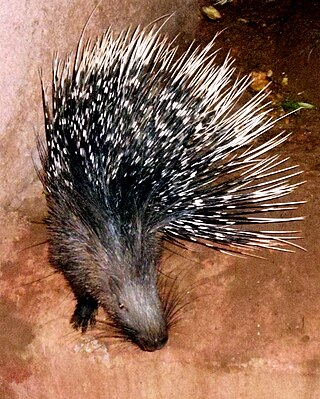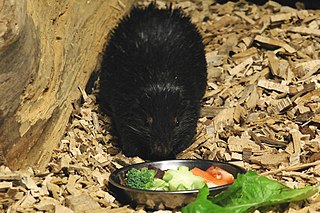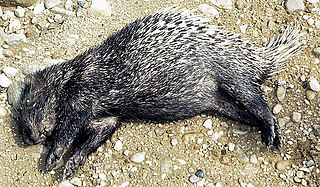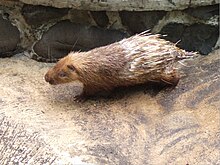
Porcupines are large rodents with coats of sharp spines, or quills, that protect them against predation. The term covers two families of animals: the Old World porcupines of the family Hystricidae, and the New World porcupines of the family Erethizontidae. Both families belong to the infraorder Hystricognathi within the profoundly diverse order Rodentia and display superficially similar coats of rigid or semi-rigid quills, which are modified hairs composed of keratin. Despite this, the two groups are distinct from one another and are not closely related to each other within the Hystricognathi. The largest species of porcupine is the third-largest living rodent in the world, after the capybara and beaver.

The Old World porcupines, or Hystricidae, are large terrestrial rodents, distinguished by the spiny covering from which they take their name. They range over the south of Europe and the Levant, most of Africa, India, and Southeast Asia as far east as Flores. Although both the Old World and New World porcupine families belong to the infraorder Hystricognathi of the vast order Rodentia, they are quite different and are not particularly closely related.

The Sunda pangolin, also known as the Malayan or Javan pangolin, is a species of pangolin.

The Cape porcupine, Cape crested porcupine or South African porcupine, is a species of Old World porcupine native to central and southern Africa.

The Indian crested porcupine is a hystricomorph rodent species native to southern Asia and the Middle East. It is listed as Least Concern on the IUCN Red List. It belongs to the Old World porcupine family, Hystricidae.

Hystrix is a genus of porcupines containing most of the Old World porcupines. Fossils belonging to the genus date back to the late Miocene of Africa.

The crested porcupine, also known as the African crested porcupine, is a species of rodent in the family Hystricidae native to Italy, North Africa and sub-Saharan Africa.

The Malayan porcupine or Himalayan porcupine is a species of rodent in the family Hystricidae. Three subspecies are extant in South and Southeast Asia.

The thick-spined porcupine is a species of rodent in the family Hystricidae. It is endemic to the island of Borneo and found in Brunei, Indonesia, and Malaysia.

The Philippine porcupine or Palawan porcupine is a species of rodent in the family Hystricidae endemic to the island of Palawan in the Philippines. It is known locally as durian or landak.

The Sumatran porcupine is a species of rodent in the family Hystricidae. It is endemic to the Indonesian island of Sumatra, where it is hunted for food.
Ratanakiri Province in northeastern Cambodia is home to many species of animals. One 1996 survey of an area to the northwest of Lomphat Wildlife Sanctuary recorded 44 mammals, 76 birds, and 9 reptile species. The following is an incomplete list of species recorded in Ratanakiri.

Acanthion is a subgenus of Old World porcupines in the genus Hystrix. It contains two species, H. javanica and H. brachyura, the smaller species with comparatively smaller nasals. The extant species have only one black ring or coloured part on the quills.














